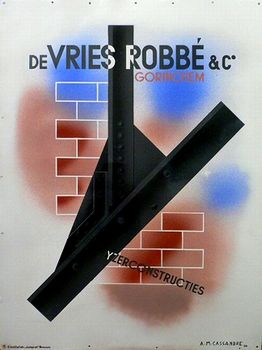(1901-1968)
Adolphe Jean-Marie Mouron, better known as Cassandre, born in 1901 to French parents in Kharkov, Ukraine, was a highly important poster artist and typeface designer of the twentieth- century.
Cassandre and his parents relocated to Paris following War World I, where as a young man he was interested in the arts, and studied at several prestigious art schools, including the Academie Julian, the Academie la Grand Chaumiere, and the Atelier Libre. He also studied at the École de Beaux-Arts. One of his earliest jobs was working for the printing shop of Hachard et Cie. The popularity of posters as advertising during the 1920’s allowed the young artist to study his preferred métier early on in his career.
As someone who was aware of the contemporary art trends, Cassandre was inspired by Cubism and Surrealism- the two art movements popular during his time, and of course the Bauhaus school, whose typography curriculum changed the nature of graphic design and elevated it to an art form.
In 1922, shortly before becoming a prominent graphic designer, the artist began to sign his works using his pen name, Cassandre. In 1923 he designed the poster “Le Bûcheron” (Woodcutter), for a Parisian cabinetmaker. This work earned him world-wide recognition, and first prize at the 1925 Exposition Internationale des Arts Décoratifs. A year prior, in 1924, his former employer, Hachard et Cie, and Cassandre signed an agreement which gave the company exclusive rights to publish the artist’s work through 1927.
The next five years were very productive. Cassandre began to create posters for leading French companies, like Danel in Lille, and produced some of the masterpieces that we have come to recognize him for, “L’Etoile du Nord”, “Le Nord Express”, Dubonnet, and “L’Intran”. Around this time he also developed several typefaces, the Bifur (1929), which has a very distinct Bauhaus look, and Steel (1930).
Through his work, Cassandre was able to tap into two important trends occurring during this period in Paris, and in art in general: the fascination with speed and technology, and the use of advertising as a means to reach a broad audience. Cassandre’s work is known for capturing the speed and urgency of the changing times. This can be seen in the posters that he created for automobiles and ocean liners, like the Normandie. In fact, his advertisement posters for the Normandie, done in 1935, are his most famous. Advertisements became another way for artists of his generation to gain visibility.
The enamel plaque and poster for the Hollandaise factory, De Vries Robbé, part of Primavera Gallery’s collection, was created in 1930. The plaque was executed by the famous enamellers Langcat Bussum and the poster by the renowned publisher Nijgh en Van Ditmar. In this work, Cassandre was able to reduce the lines and abstract the bricks of the factory’s exterior, and used the iron beams to symbolize the production which took place at the factory. By using bright colors and abstract forms, he incorporated the prevailing art trends in his poster designs.
In 1930 Cassandre joined the UAM (Union des Artistes Modernes) and also, with the help of his past associates, launched his own advertising agency, Alliance Graphique. One of his company’s most famous commissions involved the wine company Dubonnet. For this client, Cassandre designed posters in a manner which allowed them to be seen by occupants in fast-moving vehicles. Through out the decade, Cassandre developed numerous new typefaces, such as the sans serif Acier Noir (1935) and Peignot (1937), which was named after Charles Peignot, who commissioned the typeface and was a major promoter of innovation in typography.
During War World II, Cassandre served in the French army. The war forced him to close his business but he was able to keep busy by creating stage sets and costumes for the theater. This was not a new hobby, but something that he also worked on during the early 1930’s. In fact, in 1933, he had his first commission to design the interior of the Amphitryon 38 Theater. He also began to teach, first at the École des Arts Décoratifs and then at the École d’Art Graphique. From 1938-1950, he was responsible for the stage decorations at the Opera, Theater Champs-Elysees, Festival of Aix, and the Comédie Française. A lesser known fact is that Cassandre also designed the logo for the House of Yves St. Laurent in 1963.
Cassandre was fortunate to see his work recognized during his lifetime. In 1936 the Museum of Modern Art in New York held an exhibition of his work. This led Alexey Brodovitch, art director at Harper’s Bazaar, to commission cover designs from the artist. The result was three years of whimsical Surrealist-inspired work. It was also at this point that Cassandre relocated to the United States. In 1950 the Musée des Arts Decoratifs in Paris held an exhibition of his work by which they honored is twenty-five year career.
In 1968, after battling depression, Cassandre committed suicide in Paris.
Showing the single result


